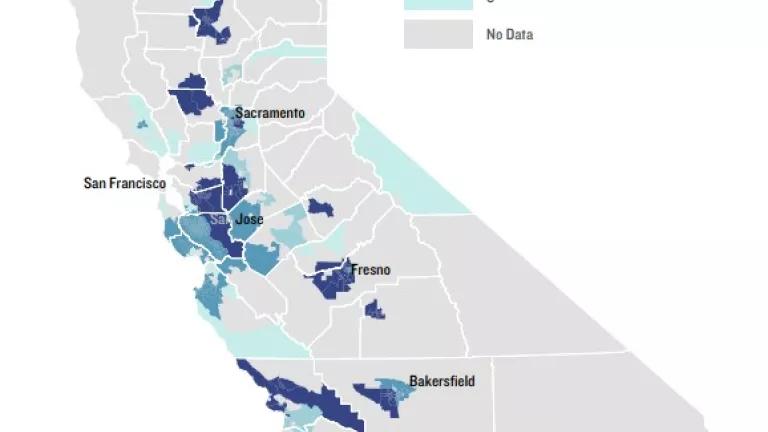California’s Lead Problem: Partials Aren't Good Enough
President Biden’s Build Back Better agenda is a big opportunity for California to create high quality water-related jobs, to protect Californians, and to right the state’s course on lead pipe replacements.

Workers with East Bay Municipal Utility District installing new water pipes in Walnut Creek, California, on April 22, 2021
President Biden’s Build Back Better agenda is a big opportunity for California to create high quality water-related jobs, to protect Californians, and to right the state’s course on lead pipe replacements. Build Back Better calls for $45 billion to replace every lead service line in America over the next 10 years, which would not only protect families from lead exposure but also create good-paying jobs in the plumbing and construction industries, as funded projects must pay a prevailing wage. The Senate-approved bipartisan infrastructure package wouldn’t fully fund the plan’s $45 billion, providing only $15 billion for lead removal.
It’s estimated that Build Back Better overall would create 2.7 million jobs. As for the water infrastructure portion, Bluegreen Alliance research found investing $105 billion over 10 years would create 654,000 job-years across the U.S. economy. Build Back Better calls for $111 billion for water infrastructure overall, so we can expect roughly 650,000 water infrastructure jobs to be created. More specifically, a recent report by Environmental Entrepreneurs found the Plan’s $45 billion for lead service line removals would create 56,000 jobs lasting at least 10 years, and infuse about $104 billion into the economy.
Economic benefits of Build Back Better’s lead replacement program wouldn’t be limited to job creation. By one estimate, replacing these lead pipes would yield $205 billion in cardiovascular health benefits alone: a 450 percent return on the investment. This figure doesn’t include the other public health costs eliminated by removing lead from our water systems. Lead’s other health effects include hearing loss, anemia, hypertension, kidney impairment, immune system dysfunction, and toxicity to the reproductive organs. Low levels of exposure can interfere with thought processes, lower children’s IQ, and cause attention and behavioral problems—all of which affect someone over the course of their lifetime. It’s estimated that each child exposed to low lead levels will lose around 73 healthy days and $50,000 in productivity over their lifetime. Supplying bottled water is expensive, too. In Flint, Michigan, the costs of supplying one day’s worth of bottled water to residents cost $22,000.
We are all paying to drink through lead pipes. And the fact is, we’re not all paying the same price—lead in drinking water disproportionately effects low-income and communities of color.

Local residents carry home cases of bottled water from the Department of Health and Welfare in Newark, New Jersey.
A recent analysis by NRDC found that there are up to 12 million lead service lines in the United States, which serve up to 20 million people. This analysis, paired with another NRDC report on lead levels in drinking water, demonstrate that while we may have incomplete information when it comes to exactly where lead is in our drinking water systems, lead plumbing is a problem throughout the nation, including in California.
Replacing lead lines has overwhelming bipartisan support—81 percent of people polled, including 76 percent of Republicans, agree that lead is a concerning issue. And 71 percent of Republicans agreed that lead line replacement should be a priority.
That’s one reason why it’s baffling that California has been such a laggard when it comes to protecting people from lead in drinking water. This year, a bill (SB 526 by Senator Min) was introduced in California that would have helped address the problem but opposition and pushback from the administration stalled the bill.
Other states, unlike California, have recognized the public health crisis created by lead exposure and prioritized full (not partial) lead line removal; these states decided not to wait for federal action. Several other states have passed bills now that federal funding is in the works. California has fallen way behind, and continues to approve harmful partial replacements, prolonging and even increasing lead exposure for Californians.
All this harm is easily prevented; California must require the full replacement of lead lines. Adding lead exposure in a state known for its drinking water problems including arsenic and nitrates is simply adding injury to injury. And children have no escape; they’re being exposed at home and at school: in Fresno County, located in California’s Central Valley, approximately 25 percent of schools reported lead in their drinking water. The state is taking steps to reduce exposure at schools and childcare centers, but leaving children exposed at home.
Build Back Better’s dedicated funding for lead service line replacements would help fix this problem and free up money for California’s other water infrastructure needs, setting us on a path to clean drinking water for all. Build Back Better would also remove any financial excuse the State Water Resources Control Board and California water utilities might have, while creating quality jobs and protecting Californians now and for generations to come. California should take this opportunity to Build Back Better.




